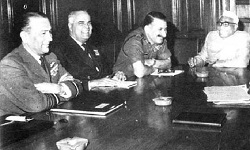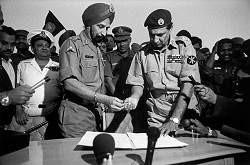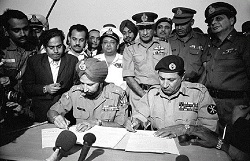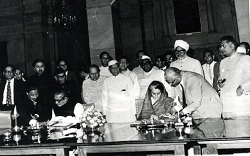
With that background, I reached Guwahati Railway station. I went to the retiring room took bath, had breakfast and then went to Military movement control office to find out the whereabouts of 4ER. They said that the entire 4Core Troops had moved towards East Pakistan border but the exact location was not known. I thought that the closest place to East Pakistan this side would be near Agarthala and hence it would be better to reach Agarthala. So I went to Airport and found out a small aircraft was ready to take-off to Agarthala and got into that and landed at Agarthala at about 4.00 pm. Couple of Army Officers also flew in that air craft and landed along with me. I approached one of them and asked whether he knew anything about 4ER. Luckily he belonged to a group in which 4ER was a part. He arranged stay for me in the night and in the morning he gave a vehicle to drop me at 4ER location.
At one place there was little traffic jam while I was travelling in the jeep and in the opposite direction another jeep was heading towards us. Since I knew the tactical no. of 4ER and judged that jeep belonged to 4ER only. I saw a civilian gentleman was seating in the front seat. Military officers were moving in civil dress to hide their identity.
I thought it could be the Commanding Officer by age and look and so I went and saluted him and said Capt. Ganesan was reporting for duty Sir. The Officer smiled and then the officer shook hand with me and welcomed me to 4ER. Since 4 ER was known to me a number of known faces smiled here and there as I entered the complex......
Readers might recollect that refugees from East Pakistan were entering India from all over the border and it became a crisis to manage at Indian side. Freedom fighters from inside East Pakistan had organised as Mukti Behni and were creating great nuisance by blowing bridges and railway tracks. Shaik Mujubur Rahman had been arrested and was taken to unknown destination. Under these circumstances Gen Yahya khan, the martial law administrator of Pakistan launched unprovoked attack on India on 01st Dec 1971.
The Indian forces retaliated in all direction both in East and West Pakistan. Indian forces from Calcutta side were to take on position from Khulna, Jessore, Rajshahi. Indian forces of Siliguri side to take on position from Dinajpur Hilli, Rangpur and there were forces at Tripura side to take on positions from Akhaura, Comilla and Bairab bazar area and so. Thus Indian forces were located from all sides of East Pakistan and when war was declared there was lightning speed of response from eastern side. Each Infantry Brigade was provided more than one Engineer Regiment to facilitate crossing of water obstacles.
My 4ER was supporting 61 Infantry Brigade for attack on Comilla-Mynamati cantt area. On 6th Dec when the war was on full swing I was ordered to go inside East Pakistan and find out the road condition whether 25 pounder Guns could be towed by jeeps in the existing tracks.
I was getting ready to go into enemy territory....
When the two forces were fighting, there were different methods to get information about each other. Secretly going into enemy territory was one such method. You might go alone, or in disguise, might take one or two for support etc. Each one method had its own advantages and disadvantages. When I was ordered to go and find out about roads, Commanding officer did not mention anything. Two officers were told to go in different direction.
So a junior officer and I set out with our personal weapons. It was 9th Dec 1971 afternoon. I took my weapon 9mm Sten gun with 28 rounds loaded and 28 rounds as spare. Since war was already in progress, my Regiment personnel were already inside international border doing different tasks. Other officer and I went and met another senior officer and told him about CO's order. That officer warned us that the Pakistanis were still at short distance away only and it was not advisable to go further inside. If we were caught they would butcher us and would not treat like a prisoner of war. The other officer was hesitant and did not proceed further. I was comparatively senior and felt that not going inside was like showing cowardice. So I decided to go inside.
As I was walking along the foot path my regiment personnel were on widening the Track. After some distance there was no one and I kept on going inside. After about 1-2 km there were bunkers on either-side and smoke was coming out from there indicating that it had just been vacated after making tea or something. It was the village Burichang of East Pakistan. The village had been totally vacated except one or two caretakers.
There one civilian came to me after recognising my OG uniform and asked me whether I was from Indian Army. I replied in affirmation. The stranger said that the Pakistan troops were still there and were in process of withdrawing to Mynamathi cantt. They would shoot me if they saw me in that dress. So he urged me to come with him to change the dress. I went with him in good faith. He gave a lungi and white shirt. I changed and kept my identity card in my boot. I then took my gun and spare bullets and was ready to move further from there.
The Pakistani forces were holding all important towns and main roads. The Mukthi Behni forces (freedom fighters of East Pakistan) had blown off some of the rail bridges and few important road bridges. Under these circumstances the Indian forces were fighting. Perhaps the Indian plan was to contain Pak forces and move forward towards Dacca. In this plan Mynamati was a big Cantonment of Comilla Complex and on the main road Comilla-Daudkhandy-Dacca.
61 Infantry Brigade was ordered to contain Comilla and cut off road leading to Dacca. For this I was told to find out suitable roads through which guns could be moved. So I was ready to go deep inside. I requested the civilian to take me to a Mukthi Behni Camp. One cycle-rickshaw was brought and I was travelling through the tracks on which guns could be moved.
I was then taken to a Mukthi Behni camp and I met their leader and explained my plan .The Mukthi Behni leader gave two escorts with guns and told them in Bengali, where all they should take me. It was about 16.30hrs and I was taken further inside along the banks of river Gomthi. Incidentally Gomthi was to be crossed to cut off the main road and I was taking a mental picture of everything as they moved. The escorts were narrating the killings that they had seen with Pak Forces while returning to their camp.
I thanked the leader and came back to Burichang where I left my Uniforms. The civilian was waiting for me and thanked Indian Army through me for helping them to get freedom. He gave a hot cup of tea and I changed to uniform and was walking back home. What a strange experience it was when I started walking in pitch dark and gun shots were heard here and there. By the time I returned to my unit it was about 22.00hrs. New orders were received that 4ER would leave a subunit with 61 Brigade and rest of 4ER would move to Brahmanbaria another important town in Bangladesh. (East Pakistan was liberated as war broke out and India recognised Bangladesh on 06th Dec)
It was 10 Dec and Indian forces were all around Bangladesh closing in to Dacca.
4ER less one field company moved to Brahmanbaria. The commanding officer, one more officer and I moved as advance party and we were given accommodation at "Sabhera Shobban Residential Girl's high school" as Officers mess. Because of war condition the school had been lying vacant for quite some time and locked by local authorities. Dacca being a free port almost all goods was from England or Germany. That being residential girls school, we saw there were number of sewing machines, blankets etc. The principal room was having TV, Fridge and other costly equipment. I was asked to note all these as we had to hand over when we moved out. Since war was on, all officers were going out early morning and returned late evening. The CO occupied principal's room and other officers suitably accommodated. The Pakistani forces also had used this building as their ammunition dumps. As Indian forces were forcing ahead the Pak forces did not offer great fight and they were withdrawing to safer places. They had withdrawn from here to Bairab bazar across river Megna and blown off the railway bridge. They also blew off all ammunitions.
The Indian forces used heliborn troops and landed near Narasigdi closer to Dacca. In order to support them there was urgent requirement of Artillery guns. So engineers made heavy rafts and loaded 130mm medium guns which could fire up to 27km. Civilian launches were retrieved from abandoned places and with the help of launch operators these gun loaded rafts were pushed along River Megna and unloaded near Narasingdi. The first shell fired from these guns landed at Dacca Airport giving a warning to Lt. Gen. A. A. K. Niazi, the overall commander of Pakistani forces in East Pakistan that Indians were closing in, forcing him to surrender.
After the first load of guns moved to Narasingdi, Troops also started moving through the river craft and each load was taken by an engineer officer. So I also was ordered to move like that. The Indian Army Chief gave a warning threat to Pakistani forces to surrender or face mass casualties. By and large the war was coming to a close.
As the pressure on the Pakistani forces was mounting from all direction, the overall commander Lt. Gen. A.A.K.Niazi had more reasons to consider the surrender. Finally it was fixed at 16.00 hours on 16th Dec 1971. Commanders of 4 core, 33 core, commanders of Navy and Air force were all invited to attend the ceremony which was to be held at Dacca Race Course. I was at Narasigdi and there was heavy rush to see the surrender. Military police imposed strict restriction for entry to Dacca.
Lt Gen J S. Arora, the Eastern Army commander flew in to sign the surrender document. In all 93000 Pakistanis were taken as prisoners and they were immediately moved to prisoner of war camp set up at different part in India.
Even though the war in east was over, there were tough fights in the west and had been heavy casualties also. In order to relieve those troops Army units from East was ordered to move to west. 4ER was one amongst them. I was detailed as commander of first military special train to leave the war zone. So the troops moved to Dharmanagar, a Railway terminal after celebrating the New Year 1972 in the New Nation Bangladesh.
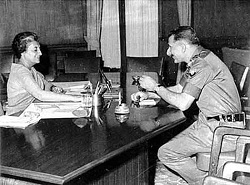
Dec 1971, Govt. of India recognised Bangladesh as an independent Nation followed by many other countries.
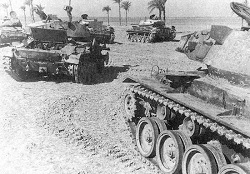
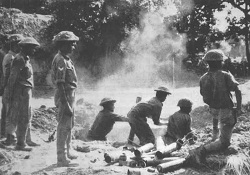
Everyone knew that East Pakistan was riverine terrain cris-crossed by distributaries and contributories of great rivers like Ganga and Brahmaputra. To conduct a military operation in that area was a challenge. The roads were limited and cross country movement would be very difficult.
